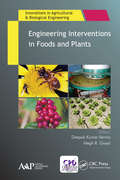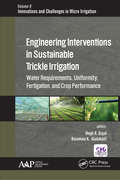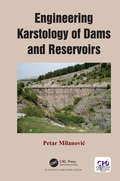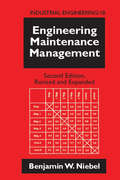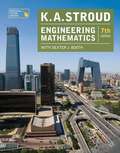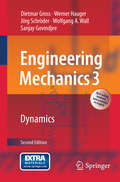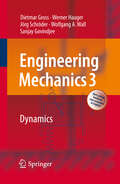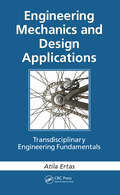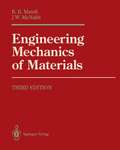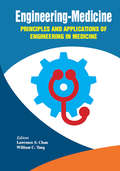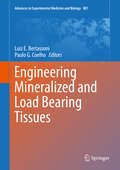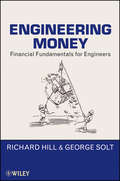- Table View
- List View
Engineering Interventions in Foods and Plants (Innovations in Agricultural & Biological Engineering)
by Deepak Kumar Verma Megh R. GoyalWith contributions from a broad range of leading professors and scientists, this volume focuses on new areas of processing technologies in foods and plants to help meet the increasing food demand of the rapidly growing populations of the world. The first section of the book is devoted to emerging entrepreneurship and employment opportunities for rural peoples in food and agricultural processing, specifically beekeeping technology and honey processing; herbal formulations for treatment of dental diseases; and engineering interventions for the extraction of essential oils from plants. Part 2 contains three chapters that discuss technological interventions in foods and plants for human health benefits, looking particularly at coffee, tea, and green leaf vegetable processing technology. The volume goes to look at several management strategies in agricultural engineering, with a chapter on production technology of ethanol from various sources and its potential applications in various industries, including chemical, food, pharmaceutical as well as biofuel. Food grain storage structures are addressed as well, focusing on minimizing losses from microbial pests as well as insect pests during grain storage by utilizing different efficient storage structures The volume provides a valuable resource for students, instructors, and researchers of foods and plants processing technology. In addition, food and plant science professionals who are seeking recent advanced and innovative knowledge in processing will find this book helpful.
Engineering Interventions in Sustainable Trickle Irrigation: Irrigation Requirements and Uniformity, Fertigation, and Crop Performance (Innovations in Agricultural & Biological Engineering)
by Megh R. Goyal Basamma K. AladakattiImproving agricultural water use efficiency (WUE) is vitally important in many parts of the world due to the decreasing availability of water resources and the increasing competition for water between different users. Micro irrigation is an effective tool for conserving water resources. Studies have revealed a significant water savings, ranging from 40% to 70% under drip irrigation compared with surface irrigation. This new volume, Engineering Interventions in Sustainable Trickle Irrigation: Irrigation Requirements and Uniformity, Fertigation, and Crop Performance, presents valuable research that evaluates crop water and fertigation requirements, examines optimum irrigation and fertigation scheduling, and analyzes the performance of agricultural crops under micro irrigation. With an interdisciplinary perspective, this volume addresses the urgent need to explore and investigates the current shortcomings and challenges of water resources engineering, especially in micro irrigation engineering. The volume discusses crop water requirements, fertigation technology, and performance of agricultural crops under best management practices. The chapter authors present research studies on drip irrigated tomato, chilies, cucumber, eggplant, cabbage, garlic, sugarcane maize, cashew nut, sapota, banana, mango, and blueberries. Removing the research gap, this volume provides new information that will be valuable to those involved in micro irrigation engineering.
Engineering Interventions in Sustainable Trickle Irrigation: Irrigation Requirements and Uniformity, Fertigation, and Crop Performance (Innovations in Agricultural & Biological Engineering)
by Megh R. Goyal Basamma K. Aladakatti Pradeep KumarImproving agricultural water use efficiency (WUE) is vitally important in many parts of the world due to the decreasing availability of water resources and the increasing competition for water between different users. Micro irrigation is an effective tool for conserving water resources. Studies have revealed a significant water savings, ranging from 40% to 70% under drip irrigation compared with surface irrigation. This new volume, Engineering Interventions in Sustainable Trickle Irrigation: Irrigation Requirements and Uniformity, Fertigation, and Crop Performance, presents valuable research that evaluates crop water and fertigation requirements, examines optimum irrigation and fertigation scheduling, and analyzes the performance of agricultural crops under micro irrigation. With an interdisciplinary perspective, this volume addresses the urgent need to explore and investigates the current shortcomings and challenges of water resources engineering, especially in micro irrigation engineering. The volume discusses crop water requirements, fertigation technology, and performance of agricultural crops under best management practices. The chapter authors present research studies on drip irrigated tomato, chilies, cucumber, eggplant, cabbage, garlic, sugarcane maize, cashew nut, sapota, banana, mango, and blueberries. Removing the research gap, this volume provides new information that will be valuable to those involved in micro irrigation engineering.
Engineering Karstology of Dams and Reservoirs
by Petar MilanovićKarst terrains have been modified and adapted through a range of human activities as the need for flood control, irrigation, food production, hydropower production and other resources has increased. Successful reclamation projects require construction of dams and reservoirs. Karst terrains present the most complex working conditions for dam foundation and realization of safe reservoir space. Practical engineering solutions are extremely complex and the need for successful solution requires serious investigations and the cooperation of a wide spectrum of scientists and engineers. A wealth of data on dam projects in karst has been collected and presented in this book. Since reservoirs in karst may fail to fill despite extensive investigations and remediation treatment the book includes a description of failures as well.
Engineering Karstology of Dams and Reservoirs
by Petar MilanovićKarst terrains have been modified and adapted through a range of human activities as the need for flood control, irrigation, food production, hydropower production and other resources has increased. Successful reclamation projects require construction of dams and reservoirs. Karst terrains present the most complex working conditions for dam foundation and realization of safe reservoir space. Practical engineering solutions are extremely complex and the need for successful solution requires serious investigations and the cooperation of a wide spectrum of scientists and engineers. A wealth of data on dam projects in karst has been collected and presented in this book. Since reservoirs in karst may fail to fill despite extensive investigations and remediation treatment the book includes a description of failures as well.
Engineering Maintenance Management
by Benjamin W. NiebelThis work sets out to furnish all levels of engineering management with the material necessary to provide cost-effective maintenance, discussing the functional design of products as well as the identification of failure systems that permit scheduled maintenance procedures. This second edition presents information on ISO 9000 requirements, utilities
Engineering Materials: Research, Applications and Advances
by K.M. GuptaIntroduces Emerging Engineering MaterialsMechanical, materials, and production engineering students can greatly benefit from Engineering Materials: Research, Applications and Advances. This text focuses heavily on research, and fills a need for current information on the science, processes, and applications in the field. Beginning with a bri
Engineering Materials: Applied Research and Evaluation Methods
by Ali PourhashemiThis book covers many important aspects of applied research and evaluation methods in chemical engineering and materials science that are important in chemical technology and in the design of chemical and polymeric products. This book gives readers a deeper understanding of physical and chemical phenomena that occur at surfaces and interfaces. The
Engineering Materials for Stem Cell Regeneration
by Faheem A. SheikhThis book reviews the interface of stem cell biology and biomaterials for regenerative medicine. It presents the applications of biomaterials to support stem cell growth and regeneration. The book discusses the stem cell interactions’ with nanofiber, gradient biomaterial, polymer- and ceramic biomaterials, integrating top-down and bottom-up approaches, adhesive properties of stem cells on materials, cell-laden hydrogels, micro-and nanospheres, de-cellularization techniques, and use of porous scaffolds. Further, this book provides a basic introduction to the fabrication techniques for creating various biomaterials that can be used for stem cell differentiation. It also elucidates the properties of stem cells, their characteristic features, tissue culture technology, properties of pluripotency, osteogenesis, and biomaterial interaction with de-cellularized organs, cell lineage in vivo and in vitro, gene expression, embryonic development, and cell differentiation.Further, the book reviews the latest applications of bio-instructive scaffold for supporting stem cell differentiation and tissue regeneration. The book also presents stem cell for dental, alveolar bone and cardiac regeneration. Lastly, it introduces engineered stem cells for delivering small molecule therapeutics and their potential biomedical applications.
Engineering Mathematics (PDF)
by K. A. StroudEngineering Mathematics is the best-selling introductory mathematics text for students on science and engineering degree and pre-degree courses. Sales of previous editions stand at more than half a million copies. It is suitable for classroom use and self-study. Its unique programmed approach takes students through the mathematics they need in a step-by-step fashion with a wealth of examples and exercises. The book is divided into two sections with the Foundation section starting at Level 0 of the IEng syllabus and the main section extending over all elements of a first year undergraduate course and into many second year courses. The book therefore suits a full range of abilities and levels of access. The Online Personal Tutor guides students through exercises in the same step-by-step fashion as the book, with hundreds of full workings to questions.
Engineering Mechanics: Volume 1: Equilibrium
by C. Hartsuijker J.W. WellemanThis is the first of two volumes introducing structural and continuum mechanics in a comprehensive and consistent way. The current book presents all theoretical developments both in text and by means of an extensive set of figures. This same approach is used in the many examples, drawings and problems. Both formal and intuitive (engineering) arguments are used in parallel to derive the principles used, for instance in bending moment diagrams and shear force diagrams. A very important aspect of this book is the straightforward and consistent sign convention, based on the stress definitions of continuum mechanics. The book is suitable for self-education.
Engineering Mechanics: Volume 2: Stresses, Strains, Displacements
by C. Hartsuijker J.W. WellemanHere is a systematic and clearly laid out text on structural and continuum mechanics. Containing hundreds of diagrams, drawings and examples, this work dovetails theoretical developments and figures in a beautifully conceived treatment of the subject. The book also covers stresses and strains in simple elements subjected to extension, bending, shear and torsion. For elementary structures, simple load displacements are obtained using both classical mathematics descriptions and engineering methods like Williot diagrams.
Engineering Mechanics: Statics: Modeling and Analyzing Systems in Equilibrium
by Sheri D. Sheppard Thalia Anagnos Sarah L. BillingtonMechanics courses tend to provide engineering students with a precise, mathematical, but less than engaging experience. Students often view the traditional approach as a mysterious body of facts and “tricks” that allow idealized cases to be solved. When confronted with more realistic systems, they are often at a loss as to how to proceed. To address this issue, this course empowers students to tackle meaningful problems at an early stage in their studies. Engineering Mechanics: Statics, First Edition begins with a readable overview of the concepts of mechanics. Important equations are introduced, but the emphasis is on developing a “feel” for forces and moments, and for how loads are transferred through structures and machines. From that foundation, the course helps lay a motivational framework for students to build their skills in solving engineering problems.
Engineering Mechanics 1: Statics
by Dietmar Gross Werner Hauger Jörg Schröder Wolfgang A. Wall Nimal RajapakseStatics is the first volume of a three-volume textbook on Engineering Mechanics. The authors, using a time-honoured straightforward and flexible approach, present the basic concepts and principles of mechanics in the clearest and simplest form possible to advanced undergraduate engineering students of various disciplines and different educational backgrounds. An important objective of this book is to develop problem solving skills in a systematic manner. Another aim of this volume is to provide engineering students as well as practising engineers with a solid foundation to help them bridge the gap between undergraduate studies on the one hand and advanced courses on mechanics and/or practical engineering problems on the other. The book contains numerous examples, along with their complete solutions. Emphasis is placed upon student participation in problem solving. The contents of the book correspond to the topics normally covered in courses on basic engineering mechanics at universities and colleges.Now in its second English edition, this material has been in use for two decades in Germany, and has benefited from many practical improvements and the authors’ teaching experience over the years. New to this edition are the extra supplementary examples available online as well as the TM-tools necessary to work with this method.
Engineering Mechanics 2: Mechanics of Materials
by Dietmar Gross Werner Hauger Jörg Schröder Wolfgang A. Wall Javier BonetMechanics of Materials is the second volume of a three-volume textbook on Engineering Mechanics. It was written with the intention of presenting to engineering students the basic concepts and principles of mechanics in as simple a form as the subject allows. A second objective of this book is to guide the students in their efforts to solve problems in mechanics in a systematic manner. The simple approach to the theory of mechanics allows for the different educational backgrounds of the students. Another aim of this book is to provide engineering students as well as practising engineers with a basis to help them bridge the gaps between undergraduate studies, advanced courses on mechanics and practical engineering problems. The book contains numerous examples and their solutions. Emphasis is placed upon student participation in solving the problems. The contents of the book correspond to the topics normally covered in courses on basic engineering mechanics at universities and colleges.Volume 1 deals with Statics; Volume 3 contains Particle Dynamics and Rigid Body Dynamics.
Engineering Mechanics 2: An introduction with many examples
by Christian MittelstedtThis book follows the classical division of engineering mechanics as taught at universities in Germany and is devoted to strength of materials, i.e. the determination of stresses and of deformations in elastic bodies. The aim of this book is to provide students with a clear introduction and to enable them to formulate and solve engineering problems in this field. For this purpose, the book provides a number of examples. This book is intended for university students of mechanical engineering, civil engineering, mechanics, but also all other courses in which the contents of this book play a role. The ContentsIntroduction to linear elasticity – Plane stress state – Bars – Beams – Beam deflections – Shear stresses in beams – Torsion – Energy methods – Buckling of bars
Engineering Mechanics 3: Dynamics
by Dietmar Gross Werner Hauger Jörg Schröder Wolfgang A. Wall Sanjay GovindjeeDynamics is the third volume of a three-volume textbook on Engineering Mechanics. It was written with the intention of presenting to engineering students the basic concepts and principles of mechanics in as simple a form as the subject allows. A second objective of this book is to guide the students in their efforts to solve problems in mechanics in a systematic manner. The simple approach to the theory of mechanics allows for the different educational backgrounds of the students. Another aim of this book is to provide engineering students as well as practising engineers with a basis to help them bridge the gaps between undergraduate studies, advanced courses on mechanics and practical engineering problems. The book contains numerous examples and their solutions. Emphasis is placed upon student participation in solving the problems. The contents of the book correspond to the topics normally covered in courses on basic engineering mechanics at universities and colleges. Volume 1 deals with Statics; Volume 2 contains Mechanics of Materials.
Engineering Mechanics 3: Dynamics
by Dietmar Gross Werner Hauger Jörg Schröder Wolfgang A. Wall Sanjay GovindjeeDynamics is the third volume of a three-volume textbook on Engineering Mechanics. It was written with the intention of presenting to engineering students the basic concepts and principles of mechanics in as simple a form as the subject allows. A second objective of this book is to guide the students in their efforts to solve problems in mechanics in a systematic manner. The simple approach to the theory of mechanics allows for the different educational backgrounds of the students. Another aim of this book is to provide engineering students as well as practising engineers with a basis to help them bridge the gaps between undergraduate studies, advanced courses on mechanics and practical engineering problems. The book contains numerous examples and their solutions. Emphasis is placed upon student participation in solving the problems. The contents of the book correspond to the topics normally covered in courses on basic engineering mechanics at universities and colleges. Volume 1 deals with Statics; Volume 2 contains Mechanics of Materials.
Engineering Mechanics and Design Applications: Transdisciplinary Engineering Fundamentals
by Atila ErtasIn the last decade, the number of complex problems facing engineers has increased, and the technical knowledge required to address and mitigate them continues to evolve rapidly. These problems include not only the design of engineering systems with numerous components and subsystems, but also the design, redesign, and interaction of social, politic
Engineering Mechanics of Materials
by B.B. Muvdi J.W. McNabb4. 2 Solid Circular Shafts-Angle of Twist and Shearing Stresses 159 4. 3 Hollow Circular Shafts-Angle of Twist and Shearing Stresses 166 4. 4 Principal Stresses and Strains Associated with Torsion 173 4. 5 Analytical and Experimental Solutions for Torsion of Members of Noncircular Cross Sections 179 4. 6 Shearing Stress-Strain Properties 188 *4. 7 Computer Applications 195 5 Stresses in Beams 198 5. 1 Introduction 198 5. 2 Review of Properties of Areas 198 5. 3 Flexural Stresses due to Symmetric Bending of Beams 211 5. 4 Shear Stresses in Symmetrically Loaded Beams 230 *5. 5 Flexural Stresses due to Unsymmetric Bending of Beams 248 *5. 6 Computer Applications 258 Deflections of Beams 265 I 6. 1 Introduction 265 6. 2 Moment-Curvature Relationship 266 6. 3 Beam Deflections-Two Successive Integrations 268 6. 4 Derivatives of the Elastic Curve Equation and Their Physical Significance 280 6. 5 Beam Deflections-The Method of Superposition 290 6. 6 Construction of Moment Diagrams by Cantilever Parts 299 6. 7 Beam Deflections-The Area-Moment Method 302 *6. 8 Beam Deflections-Singularity Functions 319 *6. 9 Beam Deflections-Castigliano's Second Theorem 324 *6. 10 Computer Applications 332 7 Combined Stresses and Theories of Failure 336 7. 1 Introduction 336 7. 2 Axial and Torsional Stresses 336 Axial and Flexural Stresses 342 7. 3 Torsional and Flexural Stresses 352 7. 4 7. 5 Torsional, Flexural, and Axial Stresses 358 *7. 6 Theories of Failure 365 Computer Applications 378 *7.
Engineering-Medicine: Principles and Applications of Engineering in Medicine
by Lawrence S. Chan William C. TangThis transformative textbook, first of its kind to incorporate engineering principles into medical education and practice, will be a useful tool for physicians, medical students, biomedical engineers, biomedical engineering students, and healthcare executives. The central approach of the proposed textbook is to provide principles of engineering as applied to medicine and guide the medical students and physicians in achieving the goal of solving medical problems by engineering principles and methodologies. For the medical students and physicians, this proposed textbook will train them to “think like an engineer and act as a physician”. The textbook contains a variety of teaching techniques including class lectures, small group discussions, group projects, and individual projects, with the goals of not just helping students and professionals to understand the principles and methods of engineering, but also guiding students and professionals to develop real-life solutions. For the biomedical engineers and biomedical engineering students, this proposed textbook will give them a large framework and global perspective of how engineering principles could positively impact real-life medicine. To the healthcare executives, the goal of this book is to provide them general guidance and specific examples of applying engineering principles in implementing solution-oriented methodology to their healthcare enterprises. Overall goals of this book are to help improve the overall quality and efficiency of healthcare delivery and outcomes.
Engineering-Medicine: Principles and Applications of Engineering in Medicine
by Lawrence S. Chan and William C. TangThis transformative textbook, first of its kind to incorporate engineering principles into medical education and practice, will be a useful tool for physicians, medical students, biomedical engineers, biomedical engineering students, and healthcare executives. The central approach of the proposed textbook is to provide principles of engineering as applied to medicine and guide the medical students and physicians in achieving the goal of solving medical problems by engineering principles and methodologies. For the medical students and physicians, this proposed textbook will train them to “think like an engineer and act as a physician”. The textbook contains a variety of teaching techniques including class lectures, small group discussions, group projects, and individual projects, with the goals of not just helping students and professionals to understand the principles and methods of engineering, but also guiding students and professionals to develop real-life solutions. For the biomedical engineers and biomedical engineering students, this proposed textbook will give them a large framework and global perspective of how engineering principles could positively impact real-life medicine. To the healthcare executives, the goal of this book is to provide them general guidance and specific examples of applying engineering principles in implementing solution-oriented methodology to their healthcare enterprises. Overall goals of this book are to help improve the overall quality and efficiency of healthcare delivery and outcomes.
Engineering Methodologies for Medicine and Sports: Proceedings of EMMS 2024 (Mechanisms and Machine Science #162)
by Roberto Montanari Maria Richetta Massimiliano Febbi Enrico Maria StaderiniThis book presents the proceedings of the International Workshop on Engineering Methodologies for Medicine and Sports (EMMS), held in Rome, Italy on February 7-9, 2024. It includes peer-reviewed papers on emerging engineering methodologies applied to biomedicine and sports, discussing topics such as advanced biomaterials, biodegradable implants, additive manufacturing of prosthesis, surface design, fabrication of bioreactors, design of biomechanical devices, rehabilitation and prevention, AI applications to medicine, biosensors, medical signal analysis, medical sensors, detection and monitoring of substances dangerous for health, biomechanics, assessment of sport performance, sport activity as a diagnostic device. A valuable, up-to-date resource, it offers an essential overview of the subject for scientists and practitioners alike, and will inspire further investigations and research.
Engineering Mineralized and Load Bearing Tissues (Advances in Experimental Medicine and Biology #881)
by Luiz E. Bertassoni Paulo G. CoelhoThis book offers a comprehensive overview of current challenges and strategies to regenerate load-bearing and calcified human tissues, including bone, cartilage,tendon, ligaments and dental structures (dentin, enamel, cementum and periodontal ligament). Tissue engineering has long held great promises as an improved treatment option for conditions affecting mineralized and load-bearing structures in the body. Although significant progress has been achieved in recent years, a number of challenges still exist.Scaffold vascularization, new biofabrication methods (3D printing, lithography, microfabrication), peptide conjugation methods, interface engineering, scaffold mechanical properties, iPS cells, organs-on-a-chip, are some of the topics discussed in this book. More specially, in the first section readers will find an overview of emerging biofabrication methods. In section 2, applied strategies for regeneration of (2.1) bone, cartilage and ligament, as well as (2.2) dentin, cementum, enamel and periodontal ligament are discussed across 14 chapters.While other volumes have addressed the regeneration of individual tissues, or exclusively focused on different regenerative strategies, the focus of this work is to bring together researchers integrating backgrounds in materials sciences, engineering, biology, mechanics, fluidics, etc, to address specific challenges common to regeneration of several load-bearing and calcified tissues. Therefore, this book provides a unique platform to stimulate progress in the regeneration of functional tissue substitutes.We envision that this book will represent a valuable reference source for university and college faculties, post‐doctoral research fellows, senior graduate students, and researchers from R&D laboratories in their endeavors to fabricate biomimetic load bearing tissues.
Engineering Money: Financial Fundamentals for Engineers
by Richard Hill George SoltThere are many text books about engineering design and some include project evaluation techniques. There are text books on accounting methods and yet others on business management. This book does not aim to replace these specialized texts but brings together the elements of these subjects that young engineers working in industry – particularly the construction industry and its customers – need to understand. Most engineers learn about money the hard way: by experience in the workplace. The authors having done this themselves recognized the gap in engineers’ education and set out to bridge it. This book is based on a 1996 course George Solt pioneered for final-year engineering undergraduates. The book is written in an approachable style and gives young engineers as well as mature engineers an insight into the way engineering businesses run, the importance of capital and the problems of cash flow.
